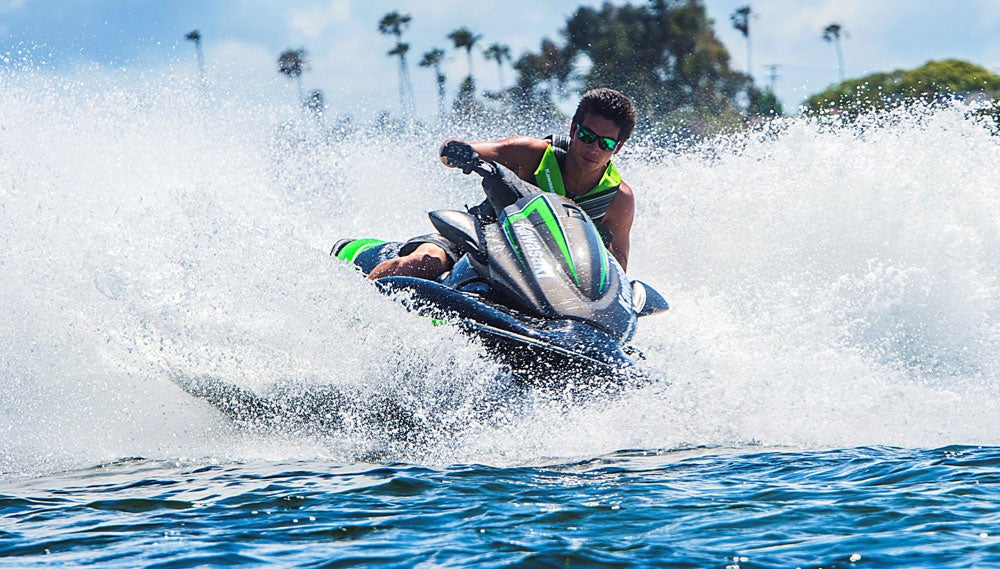2017 Kawasaki Jet Ski STX-15F Review
The oldest craft in the industry still offers good value
Kawasaki’s STX-15F was first introduced as a flagship model in 2003. In 2005, it received an engine boost to the current 1,498cc powerplant. Since then, the craft has remained virtually the same, staying on the market for an unprecedented 14 years. Obviously it has lost its flagship status. As supercharged models with larger hull designs became the norm, the craft slipped in status to the point it now ranks as Kawasaki’s introductory, recreational model. Two things, however, have kept the craft viable. As an intro-minded model, the 15F may lack the bells and whistles of its primary competitors, but it retains the power and handling that once placed it at the front of the pack.
As an intro model it may no longer need such power and handling. But for the right buyer, that very power and handling may just make all the difference in the world.
Measuring Stick
Engine: 1,498cc four-cylinder
Fuel Capacity: 16.4 gal.
Stowage Capacity: 23.5 gal.
MSRP: $9,699
The choice to stick with the long-in-the-tooth STX-15F may show Kawasaki isn’t ready to yet bet on a new introductory model, but it also shows the company still has confidence in this one-time flagship.
For sure, the craft measures up quite nicely in terms of pure specs. The 1,498cc, dual-overhead-cam four-cylinder’s power easily tops competitive models, producing 160 horses. Grab a handful of throttle out of the hole and you feel the advantage, powering to 30 mph in as little as two seconds and increasing to a top speed of 62 mph. Both figures are well beyond competitive models. Whether or not that’s too much power remains to be seen. Certainly the pure novice may initially be overwhelmed. The 15F responds quickly to throttle input, and that 62 mph figure is just a few steps behind today’s flagship models. But make a mistake and things will happen in short order. That means buyers will have to be honest about their skill levels. But as we’ve long noted, it also gives the craft a little growing room. Many once-novice riders may become bored with a slower boat once their skill levels increase. The 15F will likely keep them quite happy as that need for speed begins to rear its head.
Where the 15F begins to come up short is seen first in its dimensions. At 122.8” x 46.5”, the Kawi is both shorter and wider than the Sea-Doo GTI (132.6” x 48.5”) and Yamaha VX (132” x 48”). Weighing in at 844.5 pounds, it’s also noticeably heavier than both models. The Kawi’s added power more than compensates for the extra weight, but the saddle won’t feel as roomy and the boat may feel smaller in rough conditions. The boat’s low-slung profile adds to the latter feeling, and for some, will give the craft a slightly old-school appearance.
On the flip side, however, smaller and more powerful can be a good combo. The 15’s handling is sharper than the competitor’s offerings, and the power accentuates the feeling of the boat’s deep-V hull design, making the 15F seem far more like a racer. It dives in and out of corners with tenacity, never threatening to spin out from the load. For more serene rides, the bolstered saddle gives touring-oriented comfort, and stability is equally top notch to the competition.
Feature Set
In terms of features, competitors clearly have the advantage. The STX-15F offers only a manual reverse, a far cry from the iBR and RiDE systems offered by Sea-Doo and Yamaha. You can learn to feather the handle to approximate a neutral position, but in this era of electronic reverse, a manual system quickly feels clunky. The competitive systems also offer stopping or deceleration power underway.
The rest of the boat is similarly straightforward. Theft prevention is accomplished via a magnetic key. A second key can dial back the engine’s performance to tone things down for true beginners or to save fuel. Storage, at 23.5 gallons, is split between the bow, glovebox, and a smaller compartment under the saddle’s aft third. At 23.5 gallons, fuel capacity is in the neighborhood of competitive models.
As to price, the 15F remains at $9,699. Contrast that with two competitive models, the Sea-Doo GTI SE and Yamaha VX, both at $9,599. The latter boast more modern hull designs, electronic brake/deceleration and reverse systems, and a size advantage on the water. Sea-Doo also offers trim.
So, Kawasaki’s greatest appeal comes back down to power. It’s nothing to dismiss. A top speed that flirts with flagship numbers will hold a great deal of appeal for those with performance leanings, as will the aggressive handling of the STX hull. That combination of power and handling are precisely why the STX-15F remains a viable competitor after all these many years of production.
And why Kawasaki will be able to get at least one more year out of this long-running platform.
Get PersonalWatercraft.com in your Inbox!
Like PersonalWatercraft.com on Facebook
Comments
Most Popular

2025 Yamaha JetBlaster PRO 2-Up Review

Remembering the Sea-Doo XP

2024 Kawasaki Jet Ski STX 160X Review

Whatever Happened to the Wetbike?

2017 Kawasaki Jet Ski Ultra 310LX Review


















 Your Privacy Choices
Your Privacy Choices